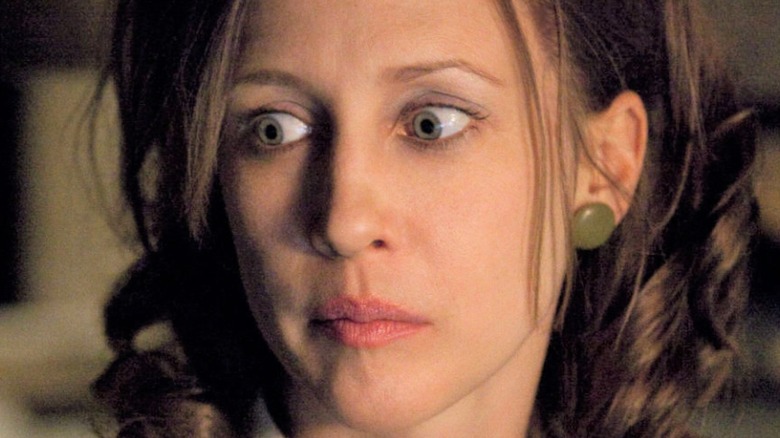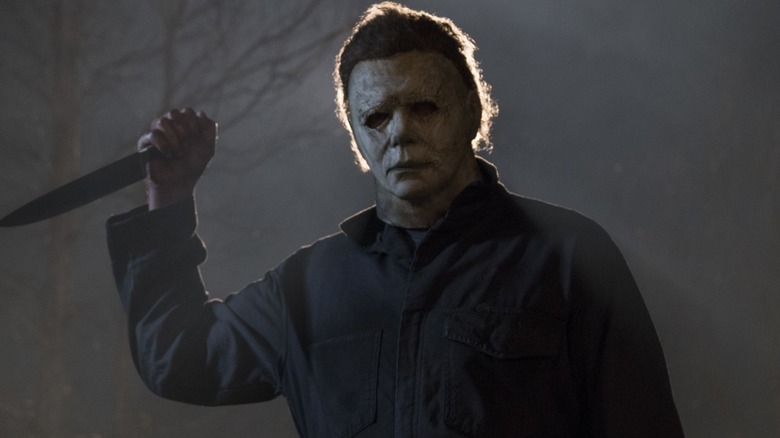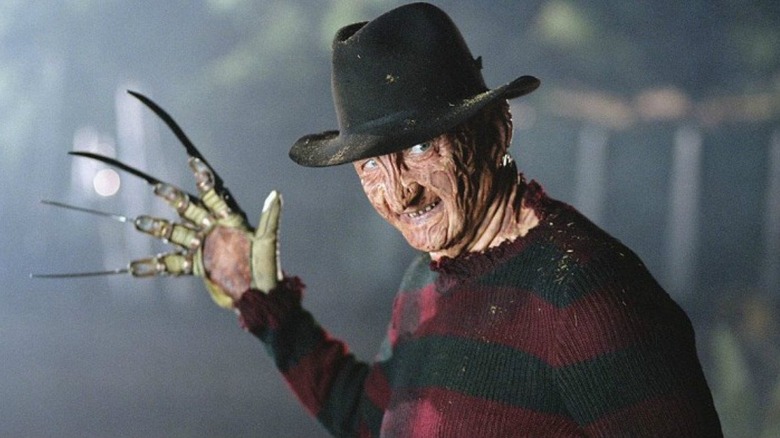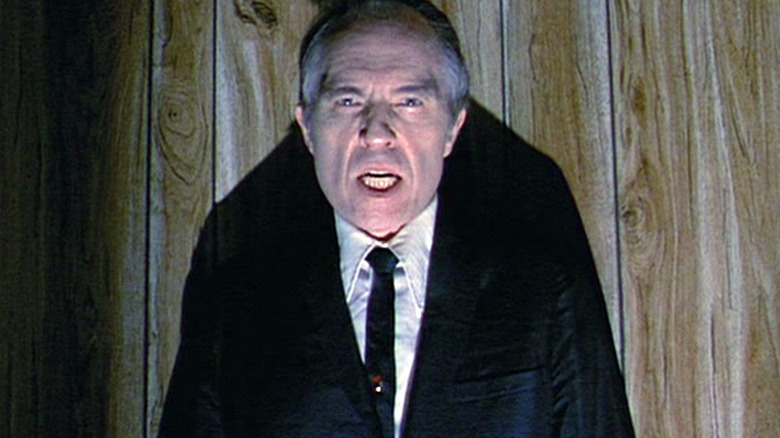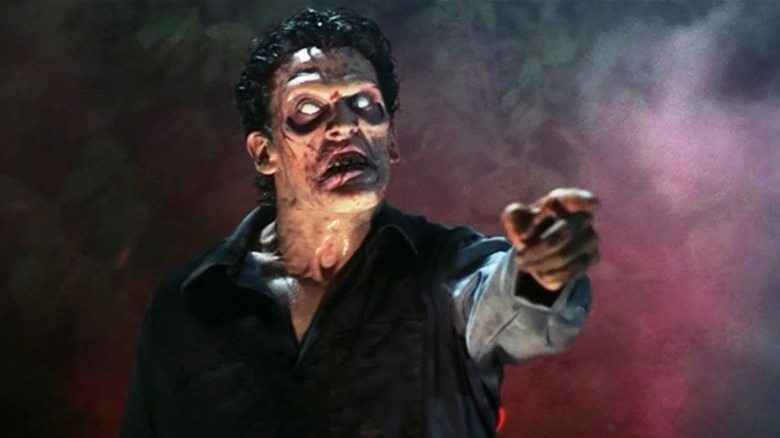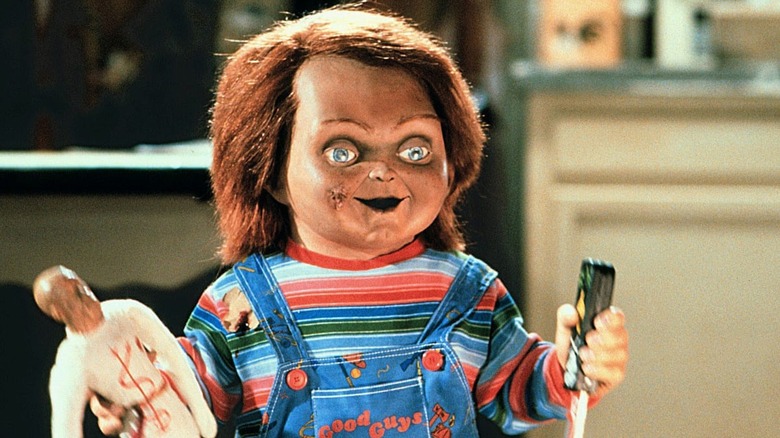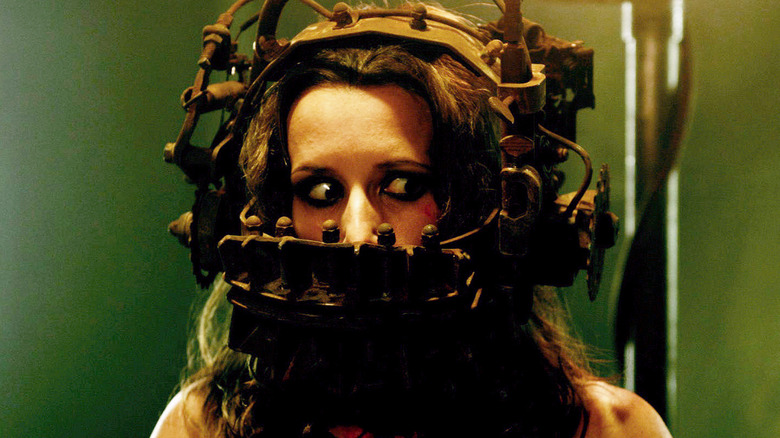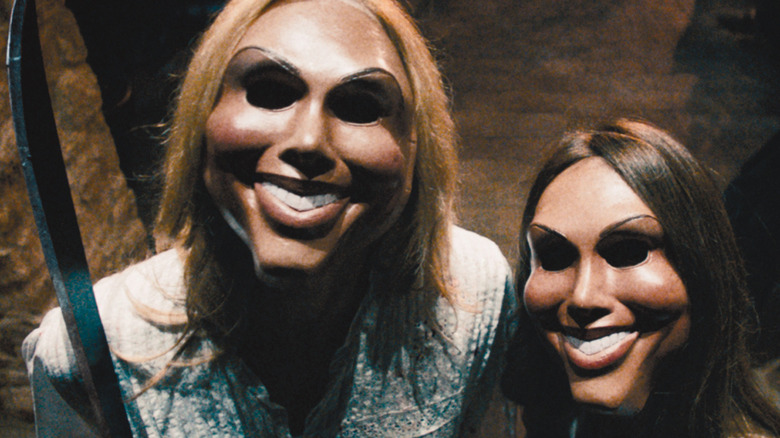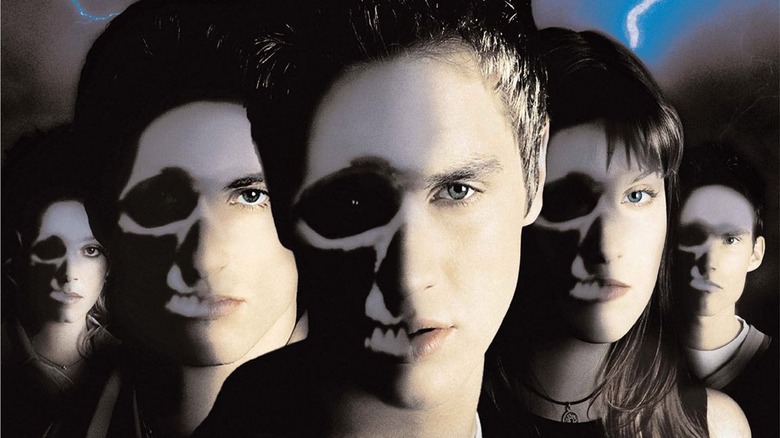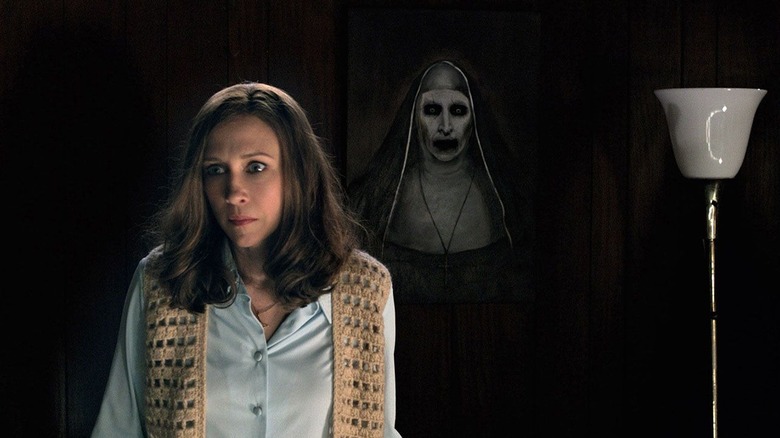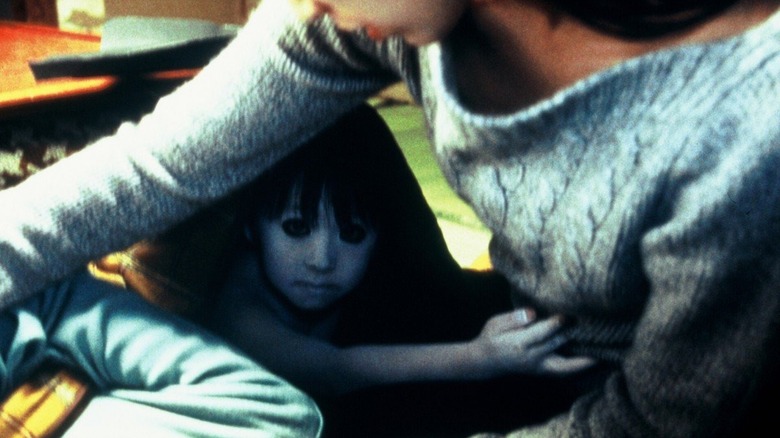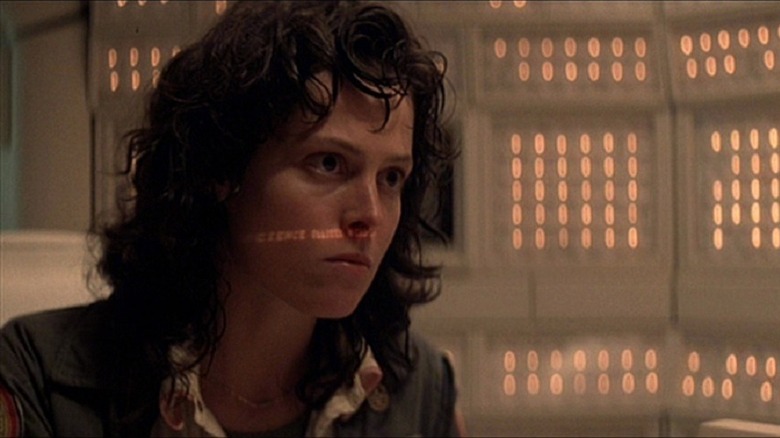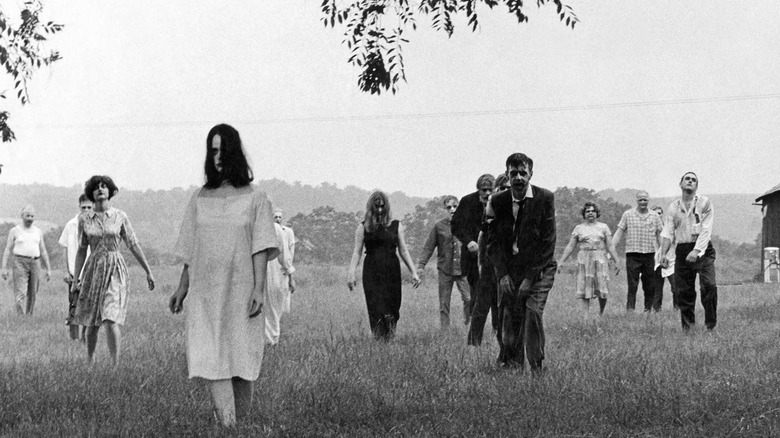The Best Scary Movie Franchises To Binge-Watch
Not all horror franchises are meant to be binge-watched. Some long-running titles get old after only one or two movies. The "Hellraiser" series, for example, started off with a bang with one of the greatest horror movies of the 1980s before devolving into direct-to-video sludge with "Hellraiser: Revelations." Similarly, the "Friday the 13th" series has its bright spots, but the individual installments are too similar to withstand being watched in a consecutive manner. They'll blend together before Jason gets a chance to take Manhattan!
However, not all horror franchises are created equal, and some are just begging for a scary movie marathon. Sometimes, this is because of the level of variety across varying installments, and other times, it's due to how a franchise slowly builds up a large mythos — like a bloody snowball getting bigger as it rolls down a hill. Whatever the reasons may be, there are plenty of horror franchises perfect for binge-watching and thus guaranteed to keep you and your friends screaming all night long.
Halloween goes (entertainingly) all over the map
Certain horror franchises just burn through sequels at a ridiculous pace, churning out cookie-cutter films that all feel basically the same. (See the "Paranormal Activity" movies, for proof.) But in the case of "Halloween," well, this series went in a different direction. Having first started in 1978, the "Halloween" saga spans over four decades of storytelling, during which it's seen several different filmmakers and aesthetics come and go. Heck, "Halloween III: Season of the Witch" even abandoned Michael Myers in an attempt to turn the franchise into an anthology series.
Watching all the "Halloween" movies consecutively means you'll oscillate wildly from John Carpenter's original restrained take on Michael Myers to the self-referential tomfoolery of later entries like "Halloween: Resurrection," which brought Jamie Lee Curtis and Busta Rhymes together on the big screen. Consuming all movies in this franchise also inevitably means partaking in the pervasively dour atmosphere of Rob Zombie's brutal reboot, which spanned two installments between 2007 and 2009, although things get classic again with David Gordon Green's "Halloween." With all the reboots and retcons, trying to keep track of any semblance of coherent mythology across these movies is a fool's errand. However, parsing out that intricate mythos — as well as seeing radically different takes on the "Halloween" universe — makes diving into this franchise more of a treat than a trick.
Nightmare on Elm Street will keep you up all night
Freddy Krueger may haunt your nightmares, but for horror aficionados, the "Nightmare" movies are the stuff dreams are made of. Starting with Wes Craven's iconic 1984 original, "Nightmare on Elm Street," the franchise took full advantage of the fact that most of these films take place in people's dreams, resulting in some truly amazing scares and visuals. The visual component became even more noticeable in later installments, which got more and more ridiculous in depicting how Krueger could kill in the domain of dreams.
Absorbing the whole series in one gulp means viewers will get to see some of the more bold horror sequels out there, such as the heavily queer-coded "A Nightmare on Elm Street II" or the incredibly meta follow-up "Wes Craven's New Nightmare." Not every entry in this series is an instant classic, sure, but the persistently unique kills and the sequels that embrace truly unusual plots make the franchise an expansive canvas worth diving into. However, even the most comprehensive "Nightmare" fan would be better off pausing the binge-watch before getting to the 2010 remake with Jackie Earl Haley. Even Haley's chilling performance as Freddy Krueger can't stop that film from being a generic stain on a frequently creative franchise.
Phantasm is an unusual but essential horror series
"Phantasm" may not be as much of a household name as, say, "Scream," but that doesn't mean it lacks a special place in the world of horror. The original entry in this franchise was released to theaters in 1979 and was such a unique creation, with its stylized imagery and unusual atmosphere, that it initially garnered a divisive reputation. But time has been kind to "Phantasm," and this audacious horror feature from writer/director Don Coscarelli has now developed a widely acclaimed reputation. Much of the praise has centered on Coscarelli's willingness to embrace the outright ludicrous at the drop of a hat.
The strangeness continued with a trio of sequels released from 1988 to 1998, with Coscarelli returning to write and direct each installment. The franchise concluded with 2016's "Phantasm: Ravager," which saw Coscarelli sitting out of the director's chair but retaining his place as a screenwriter. Because of Coscarelli's constant presence in this series, "Phantasm" is the rare long-running horror franchise to have a singular vision behind it. That vision hasn't always resulted in movies as beloved as the original, but Coscarelli's commitment to this bizarre universe makes this franchise one very much worth experiencing.
Evil Dead makes for a groovy binge-watch experience
When the first "Evil Dead" movie came out, it wasn't supposed to kick off a long-running franchise. It was just a low-budget horror movie by passionate newbie filmmaker Sam Raimi. But after it took off as a cult classic, this charmingly ramshackle horror movie spawned further films that took the series in different directions. "Evil Dead II" utilized the basic set-up of the original but took it in a larger-scale fashion that benefited from a heftier budget. It also added a whole lot of comedy to the horror. Meanwhile, "Army of Darkness" took just the Ash character for a largely standalone fantasy adventure involving skeleton, boomsticks, and the Middle Ages.
Then, 2013's "The Evil Dead" continued to take the saga into unusual directions as director Fede Alvarez reimagined the basic concept of youngsters in an abandoned cabin and added a level of tangible and brutal reality to the proceedings. There isn't much consistency across the "Evil Dead" movies, but that's what makes the series so interesting. This is especially true in regards to the first three, in which you can watch Raimi growing with confidence as a filmmaker in real time. But if there's one consistency across these movies, it's the presence of great moments of gross-out horror. Binge-watching the "Evil Dead" series will doubtlessly satisfy all your cravings for unabashedly ridiculous horror cinema.
The Child's Play movies are a cut above the rest
When the "Child's Play" movies started, nobody involved could've imagined where the series would go. If you plan to watch all the "Child's Play" movies, though, buckle up because the trajectory of this series is a wild one. Watching them consecutively means viewers will start with a pair of horror movies discernibly from the 1980s before segueing into 21st-century installments like "Seed of Chucky" that took things into unexpected and queer-coded paths. These later films saw the blood flowing — as well as the creative juices of writer/director Don Mancini, who wrote all the Chucky flicks and directed the last three.
Binge-watching just the five theatrical "Child's Play" installments already would make for a fantastically memorable experience. However, avid fans of the franchise could also throw in the two direct-to-video sequels overseen by Mancini, as well as experience an alternate version of Chucky through the surprisingly enjoyable 2019 "Child's Play" remake. Watching the series will take viewers on a roller coaster of different tones, filmmaking styles, and even incarnations of Chucky, voiced by the legendary Brad Dourif and Mark Hamill, respectively. Sure, no one expected such a journey back when this killer doll first started carving up trouble. All of that unexpectedness, though, is the gain of horror movie binge-watchers everywhere.
What a complex web the Saw movies weave
The "Saw" movies, like any torture horror series, will not be to everyone's tastes. Some people enjoy watching the creative ways these movies keep coming up with for characters to writhe in agony, but for others, it's just not their cup of tea. If this is your go-to form of horror entertainment, though, then "Saw" is an ideal fit for a night of horror binge-watching. And in an unexpected move for a slew of microbudget sequels, later "Saw" installments established a dense lore for this universe.
Jigsaw was no longer just a killer, for example. By the end of "Saw III," he became a deceased mastermind who'd left behind convoluted ways to keep his legacy going. The details of this franchise only get more and more bizarre from there, as the "Saw" sequels constantly expand upon their mythos, even as recently as 2021's "Spiral." Watching them all back-to-back can be the ideal way to pick up on all the pieces of connective tissue between individual entries, and the constant presence of new ways for Jigsaw and his proteges to kill people can keep the entertainment going. Torture horror isn't for everyone, but the "Saw" movies are for anyone who loves both the gory subgenre and binge-watching scary features.
The Purge evolved into a fascinating franchise
"The Purge" movies don't begin on the highest note. The original installment from 2013 is the least ambitious entry in the series, despite the presence of notable actors like Ethan Hawke. But the film proved successful enough to spawn a trio of follow-ups that have each gotten more confident than the last. Even better, they've all featured different lead characters. While Frank Grillo and Edwin Hodge have appeared in multiple installments, for the most part, individual "Purge" movies have opted to focus on new characters. This inclination has expanded in the most recent installments to include focusing on very specific minority perspectives, such as Black heroes in "The First Purge" or Latinx characters in "The Forever Purge."
The increasing variety and confidence in each subsequent "Purge" movie culminated in the franchise's best entry yet, "The First Purge," which saw the series dive head-first into enjoyably blunt political commentary. Absorbing these titles in a binge-watching fashion allows viewers to appreciate how this series has evolved from its inaugural entry as it adds new characters and begins to explore the titular night from the perspective of various marginalized groups. Plus, watching these films in release order allows your binge-watch to cap off on a high note. Just grit your teeth through the original "Purge," and this franchise can make for mighty fine horror marathon.
The Final Destinations movies are guaranteed to kill
There's no masked killer wandering through the various "Final Destination" movies. The antagonist here is just the presence of death itself. Death doesn't like to be cheated, and each "Final Destination" movie see's death managing to find creative ways to kill its young victims. The five entries in this franchise have gotten varying degrees of reception from critics and audiences, but none of them cut short on imaginative ways of ending the lives of their principal characters.
The fact that each new movie keeps bringing in a new crop of characters to kill off helps lend a sense of distinctiveness to each entry. Similarly, the lack of a personified presence for death across multiple features (the closest audiences get is a recurring character played by Tony Todd) means that the villain of the "Final Destination" films never loses its sense of menace. This is a sharp contrast to other horror foes like Jason Voorhees, who stick around for multiple movies and end up becoming punchlines.
There are plenty of upsides to viewing the five "Final Destination" movies in a binge-watching style, but the greatest reward is that it'll inevitably make the final "gotcha!" moment of "Final Destination 5" resonate as extra enjoyable.
There are lots of scares to choose from in The Conjuring Universe
The "Conjuring" franchise is one of the few consistently successful cinematic universes without a Marvel Studios logo attached to it. Starting in 2013 with "The Conjuring," the series has gone on to spawn not just two direct follow-ups but also a trio of "Annabelle" spinoffs, as well as a further offshoots with "The Nun" and "The Curse of La Llorona." Though the spinoffs largely work as standalone movies, they do find ways of connecting or referring to the main "Conjuring" titles, such as the ending of "The Nun," which reveals how one of the film's characters influenced the very existence of the original "Conjuring."
Fully appreciating these kinds of connections is one of several rewards you can gleam from digesting the various "Conjuring" installments in a binging mode. Another upside is examining what different directors bring to this franchise. The playful nature of David F. Sandberg's "Annabelle: Creation," for example, is starkly different from the haunted house vibes of James Wan's first two "Conjuring" movies. Though they all occupy the same space, there are different atmospheres and even time periods explored in the various "Conjuring" titles, giving us one of the rare cinematic universes to thrive at the box office.
The Ju-On films gives horror fans lots to choose from
The world of international horror is vast and dense with phenomenal titles. However, if you're specifically in the mood for a series of long-running, foreign-language horror films to binge-watch, one of your best options is the "Ju-On" series. The inspiration behind the American "Grudge" franchise, the original Japanese series has got you covered when it comes to incredibly creepy films — or even how many title you might want to marathon.
For example, if you're in the mood for only a quartet of films, you can simply partake in the original series of "Ju-On" films that ended with the pair of 2009 features "Black Ghost" and "White Ghost." However, there are plenty of other installments in this franchise if you're craving more "Ju-On" frights. For example, there are the two V-Cinema entries that predate the 2002 "Ju-On: The Grudge," which both went straight to video but helped establish the style and tone of films to come. If you want to be a full completist, though, you'd also have to include the crossover event movie "Ju-on vs Ringu," which brings together the demonic entities from the original "Grudge" and "Ring" movies. The level of variety you can incorporate into any "Grudge" marathon makes it a must-watch for horror fans.
Alien is fascinatingly ambitious horror saga
Is every "Alien" movie a classic? Of course not. No franchise that gets to six installments (eight if you wants to count the "Alien vs. Predator" crossover features) can deliver all-timers all the time. However, this series still delivered two stone-cold masterpieces with its first two films, "Alien" and "Aliens." Across these two entries, the most beloved staples of the franchise were established while also showing a refreshing refusal to just repeat the past. While "Alien" is a darker horror movie, "Aliens" is a rollicking action adventure. That particular quality can be chalked up to the different directors for each movie, with Ridley Scott helming the first "Alien" and James Cameron directing the sequel.
After "Aliens," the quality gets a lot less consistent, but that doesn't mean the rest of the franchise is devoid of merit. For one thing, it's fascinating to watch how Ridley Scott's 21st-century "Alien" movies, like "Prometheus," compare to his very first title. For another, divisive features like "Alien 3" may not be universally beloved, but they could be up your alley. That's the joy of binge-watching a series like "Alien." Not every film might be your favorite, but you could find an unexpected gem within the franchise.
Night of the Living Dead epitomizes the best of zombies and Romero
With "Night of the Living Dead" in 1967, George A. Romero forever altered zombies. Slow-walking undead figures that devour human flesh are commonplace in pop culture today, but Romero defined our modern conception of these beasts with a single film. This accomplishment alone makes his original "Night of the Living Dead" a landmark horror film, essential viewing for any connoisseur of scary fare. But Romero didn't stop there. He created a whole slew of sequels that provide the perfect basis for a frightening round of binge-watching.
While many horror sequels to famous films are low-grade cash grabs, several of these "Night of the Living Dead" follow-ups are acclaimed movies in their own right, particularly the 1978 installment "Dawn of the Dead." Not only does watching this series provide you with plenty of beloved zombie fare, but it's also intriguing to take in the unique qualities of each entry. Since Romero made most of the movies in different decades, many of the films have a unique ambiance that reflects the atmosphere of horror cinema in that era. For example, 2007's "Diary of the Dead" was the first in a resurgent wave of found-footage movies in the late 2000s, a sharp contrast to the more conventional filming techniques in the original "Night of the Living Dead." Romero's zombie fare gives fans as much food for thought as it does graphic zombie kills, and that makes them perfect movie night material.
